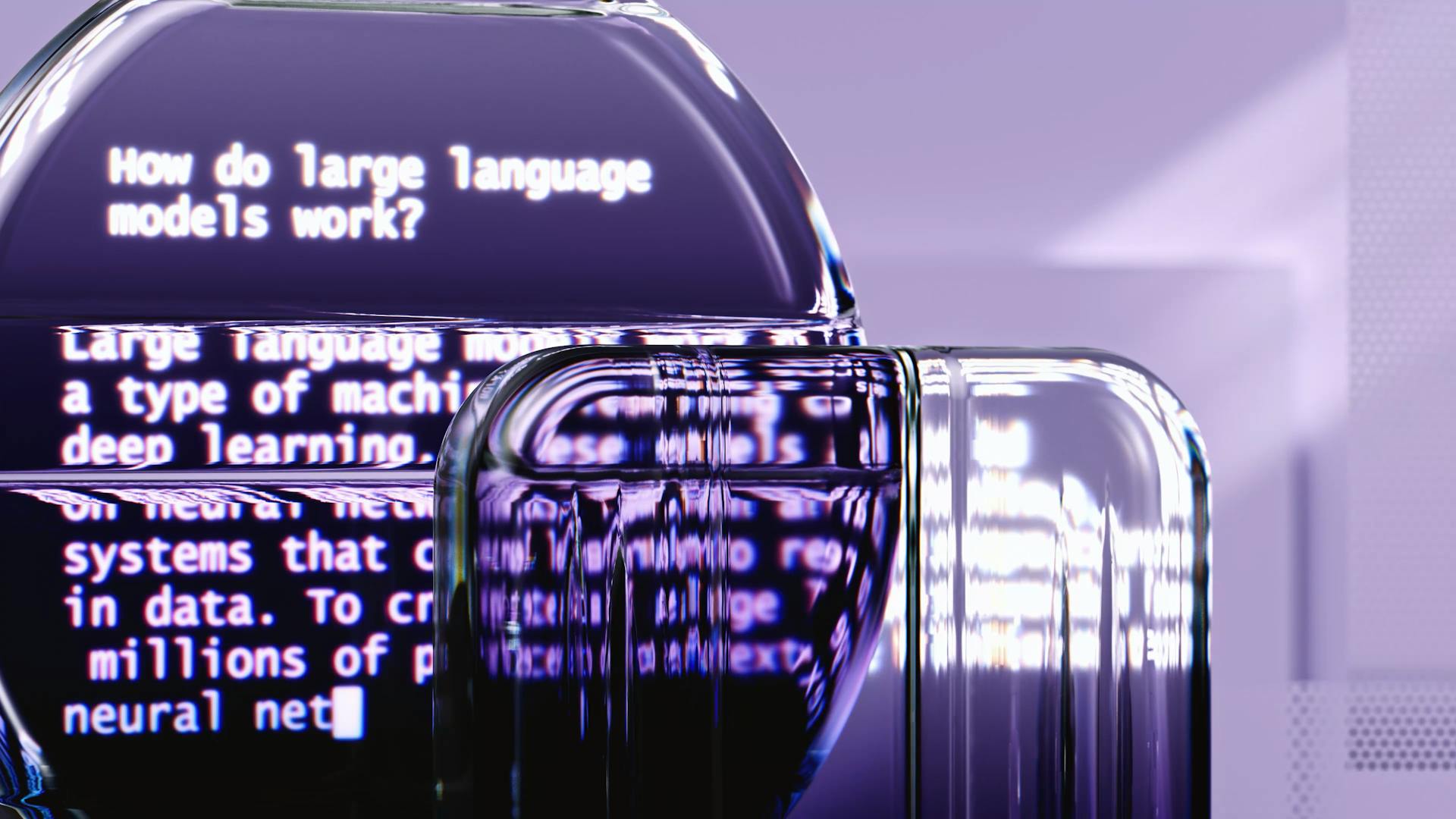
Hugging Face Chatbot is a powerful tool that makes it easy to build conversational AI models.
It's based on the popular Transformers library, which is a deep learning library developed by Hugging Face.
The chatbot allows users to interact with AI models through natural language, making it a great tool for beginners.
You can start building your own chatbot using the Hugging Face Chatbot by importing the library and loading a pre-trained model.
What Is
Hugging Face is a platform that has gained popularity in the machine-learning community due to its open-source nature, which encourages collaboration and knowledge sharing.
One of the key reasons for its success is its accessibility, providing pre-trained models to researchers, developers, and businesses, thereby democratizing NLP.
Hugging Face offers a range of tools and documentation that make it easier to start training and building models, reducing the complexity of model training and development.
This platform also provides a professional portfolio feature, allowing users to showcase their work and earn a reputation, which can be beneficial for getting jobs related to AI model training, integration, and development.
By providing a space for collaboration and innovation, Hugging Face has become a go-to platform for those looking to learn and work in the competitive AI and NLP space.
Installation and Setup
To install the required libraries for a Hugging Face chatbot, you can install Langchain directly with Huggingface using a single command.
To use HuggingFace Models and embeddings, you'll need to install transformers and sentence transformers.
You might enjoy: Hugging Face Transformers Format
Installation
To use Langchain components, you can install Langchain directly with Huggingface using a single command.
You don't need to install transformers if you're using the latest update of Google Colab, as it's already included.
To use Huggingface Models and embeddings, you'll need to install two libraries: transformers and sentence transformers.
However, if you're working in the latest Google Colab update, you can skip installing transformers altogether.
A fresh viewpoint: Langchain Hugging Face
Approach 1: Pipeline
To run the pipeline, you'll need to load the Large Language model and relevant tokenizer.
The model and tokenizer can be loaded using AutoModelForCausalLM and AutoTokenizer respectively.
For inference, you'll want to use a GPU, but since not everyone has access to A100 or V100 GPUs, you can proceed with the Free T4 GPU.
You'll need to use the orca-mini 3 billion parameter LLM with quantization configuration to reduce the model size.
To adjust the output sequence length, you can modify max_new_tokens in the pipeline.
Consider reading: Feature Engineering Pipeline
Using the Chatbot
The Hugging Face Chatbot is designed to be user-friendly, with a simple and intuitive interface that makes it easy to get started.
To interact with the chatbot, simply type your questions or prompts into the text box, and the chatbot will respond with its best answer.
The chatbot uses a conversational AI model to generate responses, which are based on patterns and relationships in large datasets of text.
You can ask the chatbot anything from simple questions to complex tasks, and it will do its best to assist you.
Intriguing read: Mlops Interview Questions
Using Inference API
Using the HuggingFace Hub Inference API can be a game-changer for large models, as it allows for faster loading and inference.
To get started, you'll need a HuggingFace Access Token, which can be obtained by logging into HuggingFace.co and following a few simple steps.
Steps to get HuggingFace Access Token are straightforward: log in to HuggingFace.co, click on your profile icon, choose "Settings", navigate to "Access Token", and generate a new access token with the "write" role.
Once you have your access token, you can use HuggingFaceHub to integrate the Transformers model with Langchain. In this case, we use the Zephyr model, a fined-tuned model on Mistral 7B.
Free Inference API has some limitations, however, and can only be used with models up to 13B.
Readers also liked: What Are Genai Use Cases Agents Chatbots
Using the Chatbot
To get started with using the chatbot, you'll need to load the models and tokenizers from the Hugging Face Hub, just like in the quickstart example. This is a convenient way to get started, but it may not be the most flexible approach.
You can use a code sample to load the models and tokenizers, and then break down each step involved in the chat process. The key steps are: loading models and tokenizers, formatting the chat using the tokenizer's chat template, tokenizing the formatted chat, generating a response from the model, and decoding the tokens back to a string.
The chatbot's performance can be improved by using a specific prompt format, which is often hidden from the user in GUIs like the one linked above. You can find a prompt template for the exact model you're using on the Hugging Face website, such as the vicuna-7B-v1.3-GGML model.
To build a chat application, you can use Pipelines from Hugging Face, such as the ConversationalPipeline, or a package like LangChain. The AutoModelForCausalLM model is a good choice for a decoder model used for text generation, and the from_pretrained method of AutoTokenizer will return a LlamaTokenizer.

Here are some key steps to keep in mind when using the chatbot:
- Use a specific prompt format to improve performance.
- Load models and tokenizers from the Hugging Face Hub.
- Format the chat using the tokenizer's chat template.
- Tokenize the formatted chat.
- Generate a response from the model.
- Decode the tokens back to a string.
Selecting and Evaluating Chat Models
HuggingFace offers a vast collection of open-source chat models, with over 120k models available on the HuggingFace Hub.
To choose the right chat model, consider two crucial factors: the model's size and the quality of its chat output. Bigger models tend to be more capable, but there's a lot of variation at a given size point.
The HuggingFace Hub provides a platform to search for models, but the sheer number of options can be overwhelming. To make a decision, consult leaderboards like the OpenLLM Leaderboard and the LMSys Chatbot Arena Leaderboard.
On the LMSys leaderboard, note that some models are proprietary, so look for the licence column to identify open-source models you can download. Then, search for them on the HuggingFace Hub.
Here's a quick guide to help you evaluate chat models:
By considering these factors and using leaderboards to compare models, you can make an informed decision and find the right chat model for your needs.
Specialized Domains and Performance
Working with specialized domains can be a game-changer for your Hugging Face chatbot. Some models are designed specifically for certain domains, like medical or legal text, or non-English languages, and can give you a big performance boost.
You might assume that a specialized model is always the way to go, but don't count out top-end general-purpose models just yet. They can still outperform specialized models, especially if they're smaller or older.
Domain-specific leaderboards are becoming more common, making it easier to find the best models for your specific domain.
For more insights, see: Tunet and Domain Adaptation
Specialist Domains
Specialist domains can be a game-changer for specific industries like medicine and law, where a specialized model can give you a significant performance boost.
Some models are indeed tailored for non-English languages, which can be a huge help if you're working with multilingual data.
You might think that a specialized model will always outperform a general-purpose one, but that's not always the case, especially if the specialized model is smaller or older.
Domain-specific leaderboards are starting to emerge, making it easier to find the best models for your specific needs.
Performance Considerations
Larger chat models are generally slower and require more memory, with memory bandwidth being the primary bottleneck in text generation.
The size of the model is a significant factor, as generating text is unusual in that it's bottlenecked by memory bandwidth rather than compute power.
A 16GB model, like the one in our quickstart example, requires 16GB to be read from memory for every token generated.
Total memory bandwidth can vary greatly depending on the hardware, ranging from 20-100GB/sec for consumer CPUs to 2-3TB/sec for data center GPUs like the Nvidia A100 or H100.
To improve text generation speed, you can either reduce the size of the model in memory or get hardware with higher memory bandwidth.
Assisted generation, also known as "speculative sampling", is a technique that can alleviate the bandwidth bottleneck by guessing multiple future tokens at once and then confirming them with the chat model.
This can greatly improve generation speed, but it's generally ineffective for Mixture of Experts (MoE) models, which have lower memory bandwidth requirements despite their large size.
You might like: Claude Ai Chat
Frequently Asked Questions
What is hugging face AI used for?
Hugging Face AI is used for building, deploying, and training machine learning models, enabling users to integrate AI into live applications. It provides a platform for users to create, test, and deploy AI models in a variety of settings.
Can I use Hugging Face for free?
Yes, Hugging Face offers a free tier for everyone, allowing you to train models for a limited number of samples without any cost. Get started with free access and explore the possibilities of Hugging Face!
Sources
- https://www.analyticsvidhya.com/blog/2023/12/implement-huggingface-models-using-langchain/
- https://www.makeuseof.com/what-is-hugging-face-and-what-is-it-used-for/
- https://www.sramanamitra.com/2024/10/18/ai-unicorns-hugging-faces-successful-pivot-away-from-teenage-chatbot-engine/
- https://huggingface.co/docs/transformers/en/conversations
- https://stackoverflow.com/questions/76775865/how-to-use-huggingface-models-for-chatbot-like-answers
Featured Images: pexels.com


